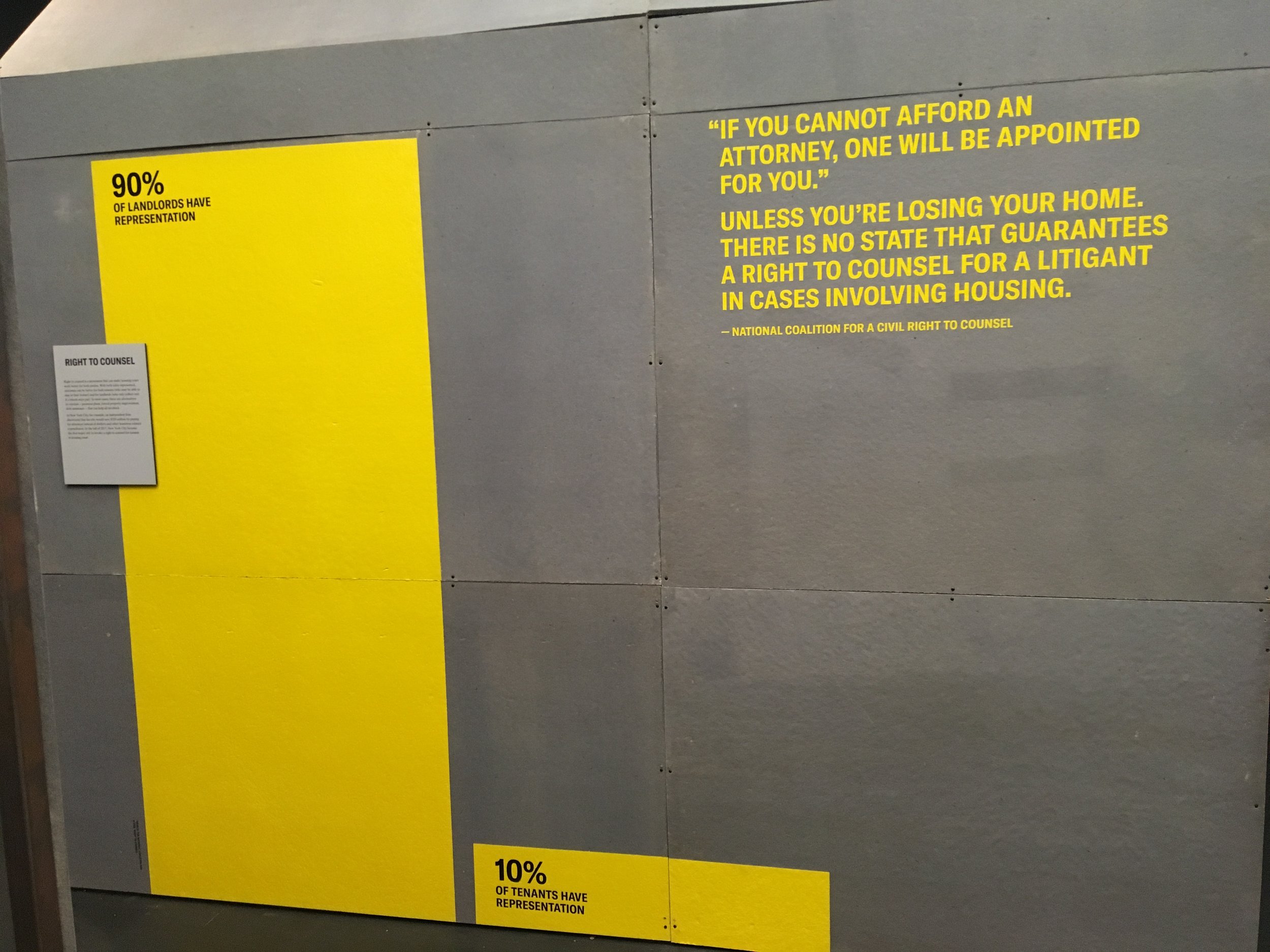The National Building Museum is currently running an exhibit illustrating the inequities of homeownership and eviction. The exhibit uses a ton of images and audio interviews to show the devastating effects of eviction. The visual infographics and forward-thinking design introduce visitors to the numbers and statistics they need to know in order to understand the crisis. Rates of evictions in different markets make evident the depths of the problem. Americans often take home for granted—homes form the building blocks of community life.
(It scrolls!)
The spectrum of the housing conversation spans from homeownership to homelessness, with homelessness being the physical crisis in the housing discussion. We can all agree that housing is a basic need - people can’t live without food, clothing and shelter. Unfortunately, many folks are a financial crisis away from eviction. People living paycheck to paycheck can often survive a crisis with credit cards and payday loans; but, two crises that occur simultaneously, like a car repair and health issue, can tip them over onto the slippery slope that leads into homelessness. Other people may be suffering from addiction or mental health issues that impede their ability to be gainfully employed or make rent. The differing causes of homelessness mean that there are different types of homeless populations. Those different populations each benefit best from their own approach.
The “housing first” approach considers housing as the first step to getting and keeping people’s lives together. Without housing there is little possibility of situational recovery – whether it be financial, health or dependency. Many organizations have found when they are able to anticipate issues and aid – in advice, provisions or short-term financial assistance – many facing a crisis in housing are able to craft their own solution. The best way to solve a problem is to anticipate the problem. It is much more difficult to deal with homelessness after the fact. There must be accountability within our communities – knowing who is homeless and who is on the verge. Communities must understand the detail of both supply and demand side and have assets in place to have the ability to respond quickly.
There are many ways to address the “housing first” approach. For example, health care giant Kaiser Permanente has invested over $200m in multiple states to construct housing based on the idea that “housing is healthcare”. They have found it is more cost effective to keep people under roof rather than to treat the different negative health outcomes that homelessness causes (injuries from extreme temperatures, HIV/AIDS, tuberculosis, diabetes, and malnutrition are among the chief health issues). In other words, a member of the health care industry is constructing affordable housing to help prevent health crises that often result from homelessness, finding housing (access to, type, size, affordability) has a direct relationship to our health.
Housing must be first, but housing alone is not enough. Addressing homelessness is a team sport and there must be coordination among the different stakeholders:
· City and county governments
· Health care and veteran’s administration
· Housing authority
· Non-profits and social service agencies
There are two notable examples of different organizations working along these lines:
Community Solutions is a non-profit group doing comprehensive work in communities to end homelessness by analyzing and changing policies that contribute to the problem. From their website: “Community Solutions helps communities adopt the best problem-solving tools from multiple sectors to end homelessness and the conditions that create it. We are partnering with communities to build a new problem-solving infrastructure, rooted in real-time data and driven by human-centered design and constant improvement. The problem-solving skills and tools we teach enable meaningful collaboration, produce trustworthy information, highlight the value of local assets, and remind communities that problems like homelessness are both urgent and solvable.” Their interdisciplinary approach encourages “outside the box” thinking. For an extended review, check them out.
Community First Housing Village is a 51-acre master planned community of tiny homes, RV’s and support structures that provides affordable, permanent housing and community for the chronically homeless in Central Texas. Supportive villages for homeless populations are becoming more common. These communities go beyond simply providing shelter; providing a stable supportive community and services as well. The project was possible because it is outside the city limits where there are no zoning codes that would restrict such a development. Placement outside of the city limits likely limits the community’s access to other services and support (education, healthcare, work) however.
We need to understand the depth of the stories and situations that lead to not having a consistent place to live. The focus should be on addressing causes and helping people maintain housing. While shelters are an important piece of the puzzle, they serve the emergency and ideally temporary needs – they are not permanent solutions. Additionally, they are ineffective without a broader understanding and “then what” approach to housing needs. Similarly, to the term “affordability” we should retire the term “homeless”. It’s too easily stereotyped and betrays the complexity and depth of the issue.
Next week we discuss how we might approach housing for everyone.




